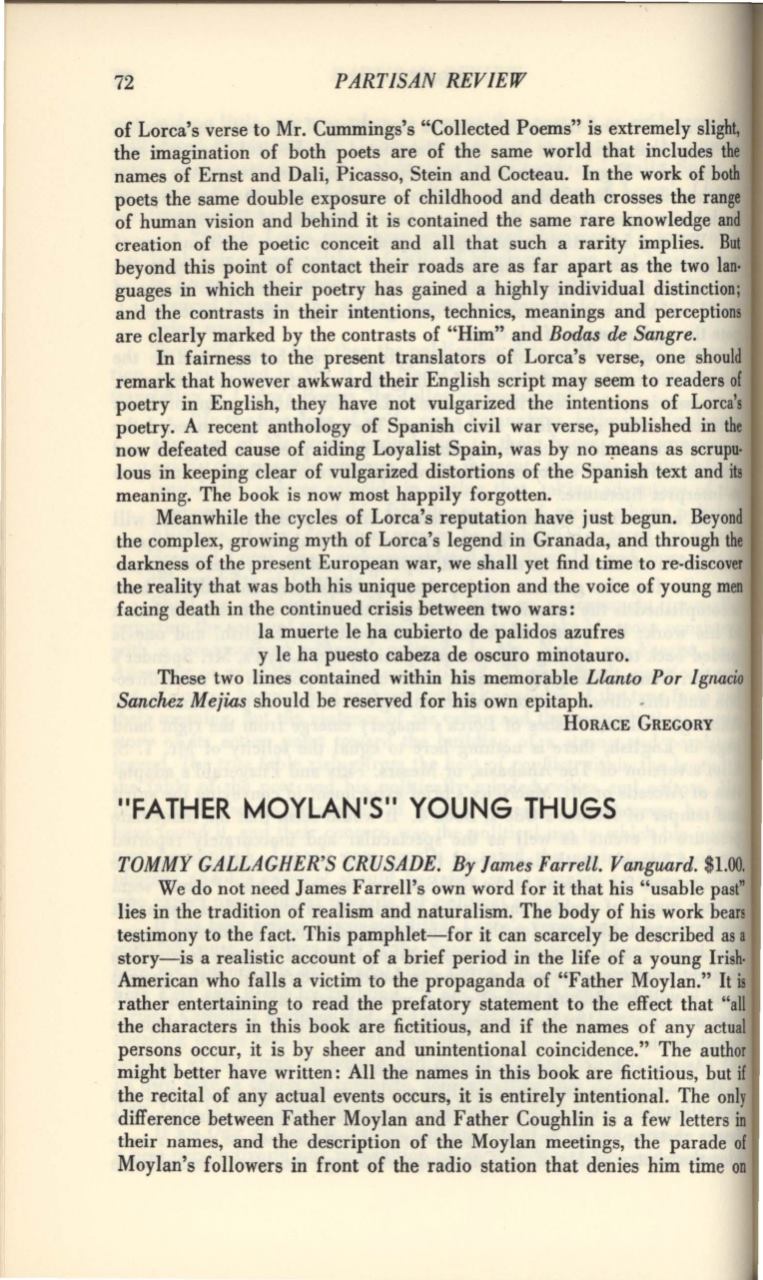
72
PARTISAN REVIEW
of Lorca's verse to Mr. Cummings's "Collected Poems" is extremely
sligh~
the imagination of both poets are of the same world that includes
the
names of Ernst and Dali, Picasso, Stein and Cocteau. In the work of both
poets the same double exposure of childhood and death crosses the range
of human vision and behind it is contained the same rare knowledge
and
creation of the poetic conceit and all that such a rarity implies.
But
beyond this point of contact their roads are as far apart as the two Ian·
guages in which their poetry has gained a highly individual distinction;
and the contrasts in their intentions, technics, meanings and perceptions
are clearly marked by the contrasts of "Him" and
Bodas
de
Sangre.
In fairness to the present translators of Lorca's verse, one should
remark that however awkward their English script may seem to readers of
poetry in English, they have not vulgarized the intentions of Lorca's
poetry. A recent anthology of Spanish civil war verse, published in
the
now defeated cause of aiding Loyalist Spain, was by no
~eans
as scrupu·
lous in keeping clear of vulgarized distortions of the Spanish text and its
meaning. The book is now most happily forgotten.
Meanwhile the cycles of Lorca's reputation have just begun. Beyond
the complex, growing myth of Lorca's legend in Granada, and through the
darkness of the present European war, we shall yet find time to re-discover
the reality that was both his unique perception and the voice of young
men
facing death in the continued crisis between two wars:
Ia muerte le ha cubierto de palidos azufres
y le ha puesto cabeza de oscuro minotauro.
These two lines contained within his memorable
Llanto Por Ignacio
Sanchez Mejias
should be reserved for his own epitaph.
HoRAcE GREGORY
"FATHER MOYLAN'S" YOUNG THUGS
TOMMY GALLAGHER'S CRUSADE.
By
James Farrell. Vanguard.
$1.00.
We do not need James Farrell's own word for
it
that his "usable past"
lies in the tradition of realism and naturalism. The body of his work bean
testimony to the fact. This pamphlet-for it can scarcely be described as a
story-is a realistic account of a brief period in the life of a young Irish·
American who falls a victim to the propaganda of "Father Moylan." It
is
rather entertaining to read the prefatory statement to the effect that "all
the characters in this book are fictitious, and if the names of any actual
persons occur, it is by sheer and unintentional coincidence." The author
might better have written: All the names in this book are fictitious, but if
the recital of any actual events occurs, it is entirely intentional. The only
difference between Father Moylan and Father Coughlin is a few letters
in
their names, and the description of the Moylan meetings, the parade of
Moylan's followers
in
front of the radio station that denies him time on


